Once upon the time there was a little Princess … or wait, she wasn’t even born yet. Her grandmother Queen Mother Emma and her mother Queen Wilhelmina already received dolls regularly when travelling through the Netherlands. So when Wilhelmina, after several miscarriages, finally again fell pregnant in 1908, the Dutch people were delighted. Already on 4 April 1909 the Queen received a delegation from the fishing village of Urk and was presented with a doll in their Sunday dress for girls.
The baby turned out to be a girl and was called Juliana. As a little girl of course she loved playing with dolls, and her mother – an avid photographer – liked to take the official photos of her daughter herself, and regularly there were dolls to be seen on these photos. In 1912 even a Juliana doll was created, as had previously been done for Queen Mother Emma and Queen Wilhelmina. Dolls of course were not only meant to play with. They were also used to teach little princesses how to behave and how to dress.
Already when Juliana was a little child, media wrote about her collection of dolls. Somehow that gave many people the idea of presenting her with a doll, a tradition that continued throughout her life. During visits in the Netherlands, and also at Queen’s Day celebrations, she regularly received dolls, many in costumes. But also at foreign visits people loved to present her with another doll. The Koninklijke Verzamelingen (Royal Collections) contain more than 600 dolls.
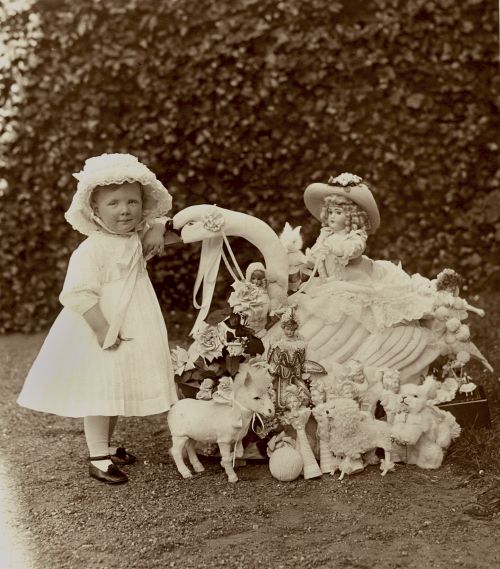

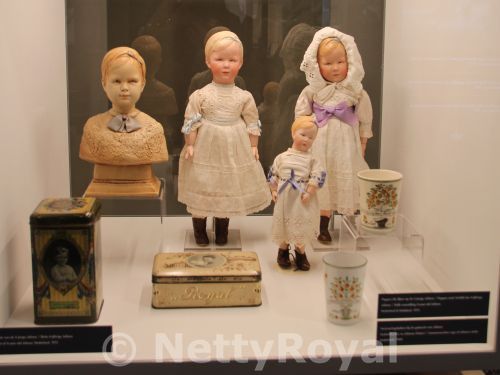
Exhibitions
I remember having seen many of these dolls at an exhibition at Palace Het Loo in Apeldoorn 2010, but there were so many and all in rather huge showcases. A few years ago the Veluws Museum Hagedoorns Plaatse in Epe (The Netherlands), the Hessisches Puppen + Spielzeugmuseum in Hanau (Germany), the Manufaktur der Träume in Annaberg-Buchholz (Germany), the Borg Verhildersum (The Netherlands) decided to organize a travelling exhibition of the dolls of Juliana. They succeeded with the help of the Royal Collections and the Mondriaan fonds. A video about the exhibition in Hanau.
It was the first time ever the collection travelled abroad. The exhibition “Juliana. Een eeuw in poppen | A Life in Dolls” (see website) was shown in Epe from 2 April to 21 December 2019, where I somehow missed it. Afterwards the dolls were supposed to be exhibited in Germany … but then Covid-19 came. The exhibition in Annaberg-Buchholz could finally open its doors from 15 July to 31 October 2021, Hanau was able to present the dolls from November 2021 until 24 April 2022 and was happily surprised to attract thousands of visitors. And then they finally travelled to Verhildersum, where the exhibition had to be put together in one week! A real challenge, but they succeeded. Only some of the signs still have to be translated into Dutch. I was told the exhibitions are more or less the same, but that the exhibition in Epe showed less dolls than the one in Verhildersum, as there is a bit more space in Leens.
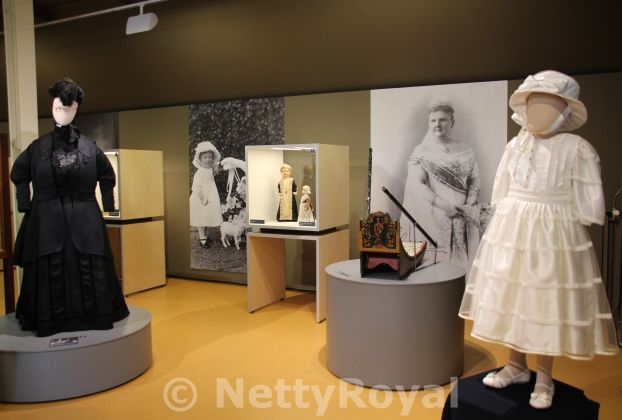
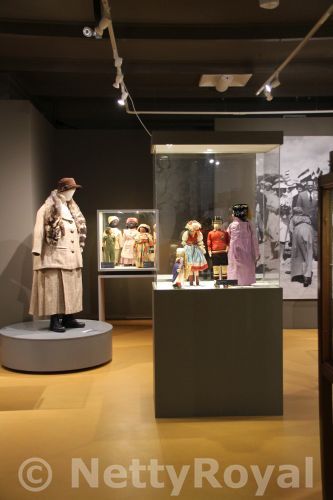
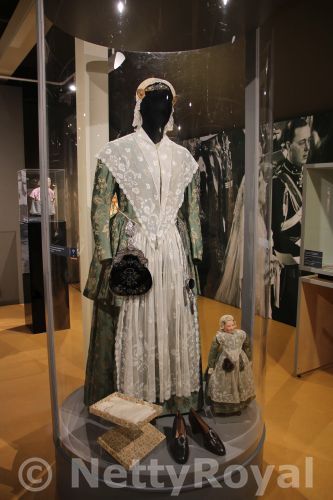
Opening of the Verhildersum exhibition
Living pretty close to Verhildersum I was happy to be able to attend the opening of the exhibition “Juliana, een leven in poppen” on Saturday 30 April 2022, 113 years after the birth of Queen Juliana. In the late afternoon guests – mainly volunteers and friends of the Verhildersum estate, and some people who had helped putting the exhibition together, including avid royal collectors Dennis & Ron, and not to forget their dog Lilly – were invited for the official opening at “Ons Schathoes”, the restaurant of the estate.
The director of the estate Verhildersum, Monique Spaltman, opened the event by telling a bit about the newest projects of the museum, which contains more than a small mansion, a restaurant and a garden full of statues by Eddy Roos. There are even cycling and walking routes through the area, that still has to be discovered by tourists. She said the museum hopes that the exhibition will attract more visitors for the own collection too.
Then Patrick Reeuwijk, the director of the Veluws Museum Hagedoorns Plaatse informed about the international cooperation for the exhibition. He said, that as the dolls hadn’t been on display a lot, they had wanted to organize something more. Items that not often leave the depot of the Royal Collections were now given on loan. He said that the dolls actually tell a story, a whole history from Julianas birth to for example Suriname and the Dutch Indies. It also shows whom she met over the years, where she travelled. And if one looks to all the details, one notices that Juliana didn’t always receive cheap dolls: they were often decorated with real gold, silver, diamonds.
For the official opening the chief editor of the Dutch royal magazine “Vorsten” was asked. Justine Marcella was quite honoured. It was her very first opening by herself, and she confessed that in her world openings are usually done by princesses and queens. She herself has a collection of royal dolls, that include King Willem-Alexander and Queen Máxima, and she wonders if there will ever be a Princess Amalia doll. Justine told that the doll collection was actually more or less forced on Juliana, and she can’t remember Juliana really had dolls exhibited in her own home, Palace Soestdijk. Most of them were probably part of the Royal Collections, where official gifts normally are being collected. The fact that the exhibitions were possible, is also thanks to King Willem-Alexander, who easier loans items from the Royal Collections than his predecessors.



Then it was time to head for the coach house, where Justine untied a small orange ribbon. After the director and Justine I was actually the first to enter the exhibition. Not only 65 dolls are on display, including gifts by US-First Lady Eleanor Roosevelt and King Haakon VII of Norway. Also three costumes of Emma, Wilhelmina and Juliana were recreated. Den Ron Collections lend some of their memorabilia. One of the highlights for me as a Frisian woman was the traditional Frisian costume that Juliana received as a wedding gift in December 1936 including an antique scarf, a silver clasp and antique jewelry. A year later she was presented with a doll that looked like her, wearing the exact same costume, apart from the J on the chatelaine bag.
After a visit to the museum farm with more non-royal exhibitions a reception was held in the restaurant. Unfortunately there was hardly enough time to have a good look at the exhibition and all the dolls, even when the exhibition area is not very big. The director gave me the opportunity to have another quick look after the reception. I guess I will have to return this summer to have a better look and finally have a look inside the mansion itself. And hopefully I will also be able to listen to the audio tour. I am not much of a fan of these, but as there is little information going with the dolls, the mediaguide – for which you need a mobile phone – is recommendable. Although I did get a nice information sheet with small pictures and texts, that is both in Dutch and English.
Visit
To come all the way to Borg Verhildersum in Leens only for the exhibition is maybe a bit too much for people. But in combination with a visit to the mansion, a walk through the lovely garden, a visit to the museum farm and maybe a tour around the area by bike, car or on foot, I would certainly recommend it. There are other nice mansions, as well as lovely villages nearby, like Pieterburen (sealcentre), or you can go to the city of Groningen and enjoy views over the city from the top of the new Forum.
The exhibition is open until 31 August 2022.
Souvenirs
The book published on the occasion of the exhibitions – Juliana. Ein Jahrhundert in Puppen | A Life in Dolls – is curiously written in English and German (unless I accidentally missed one with Dutch text). It was published in 2021 by the Veluws Museum Hagedoorns Plaatse in Epe. Texts were written by Victoria Asschenfelddt, Bauke Boersma, Fabian Busch, Trudy Rosa de Carvalho and Elke Tetterode Ravenstein. The book costs € 17,95 and is available in the shop at Verhildersum.
I also spotted a post card of Queen Juliana I think. I am not sure if there will be more.

Thank you Netty, for your visit and this nice article. We look forward to welcome everyone interested in the history of the Dutch royalty and in beautyful dolls at Museum Verhildersum in Leens, Groningen.
Thank you! I felt very welcomed. I tried to make notes, but it was so much to take in that I easily might have missed something or misunderstood something. So if there is anything left out, or wrongly written, let me know.
Mooi stuk geworden Netty . Zeer uitgebreid en informatief.
Proficiat.
Groet
DenRonCollections
Bedankt voor het leuke verslag Netty! Ik mis alleen de vermelding to wanneer de tentoonstelling te bezoeken is?
Oeps … zal ik zo even toevoegen.